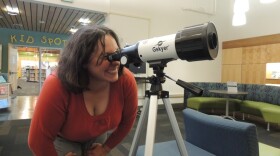Two locals are trying to bring the Civil Air Patrol back to Homer.
The program is the “civilian arm” of the U.S. Air Force, and is made up of cadet and adult volunteers. In Alaska, there are about 750 members who belong to 17 squadrons located throughout the state, including one in Kenai.
CAP provides aid during natural disasters and assists the Air Force and local emergency service agencies – like the police and fire departments – in search and rescues.
CAP Lt. Col. Douglas Stark and his wife Sandy, both in their 80s, said Homer hasn’t had a squadron for several years, due to a lack of volunteers. But they’re hoping to get more locals involved to bring the squadron back.
“We're all just civilians,” Sandy said. “We're not in the Air Force, and everybody just donates time. But interestingly enough, they say over 95% of all aircraft search and rescues for the Air Force are done by us volunteers.”
The CAP was congressionally chartered on Dec. 1, 1940 with three missions — cadet programs, aerospace education and emergency services, according to CAP Lt. Col. Bryan Emerson, public affairs officer for the Alaska wing of the program.
CAP’s cadet program is for adolescents between the ages of 12 and 18. Emerson said lieutenants work with cadets to help develop their leadership skills.
He said they also work with kids of all ages throughout Alaska, including in the bush, on aviation and aerospace education.
One of CAP’s main objectives is to assist in local search and rescue efforts. That could be by plane or helping with ground searches.
“How that would relate to Homer would be when we get a call from the Rescue Coordination Center that says an airplane is down, or maybe a kayaker is lost or a surfer hasn't returned, then we would send the plane up to do a search in that area,” Emerson said. “And then hopefully, when we find the person or the wreckage…the Air Force would then send in a helicopter to those GPS coordinates to do a rescue.”
Sandy Stark, who’s trying to restart the local squadron with her husband, said CAP still owns two hangars and an office in Homer. All they’re missing is members.
“It's fascinating work,” she said. “If we can get enough cadets, we help them learn about aerospace and aviation, and they even get help getting to start being in an airplane and do the stuff to eventually get a pilot's license.”
CAP is looking for private pilots, wannabe pilots or community members interested in public safety – including 12 to 18 year olds interested in becoming cadets – to join the Homer squadron.
Sandy said they’re also looking for people who can help observe from the plane during rescues.
“The pilot is gonna give full attention to flying the plane safely,” she said. “The observer has got to concentrate on looking out the window. And they teach you patterns of observing, ways to move your eye vision around so that your odds of spotting things increase from just normal, ordinary, glancing around.”
Sandy said they’ve had a few people express interest in volunteering with CAP so far, but they’re looking for more. Emerson said they need at least six members to create the squadron, with at least two adults for supervision.
“We want to have a diverse squadron, in terms of ages and races and genders, because the diversity really helps us draw from many backgrounds and many perspectives to make a successful mission,” Emerson said.
Community members interested in joining the Civil Air Patrol squadron can get in contact with the Starks by calling (907) 235-5537.






